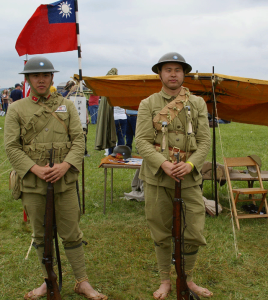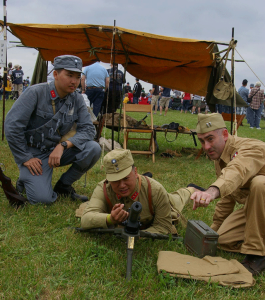Re-enacting the Sino-Japanese War
- By Peter Harmsen
- 7 October, 2013
- 1 Comment
 History can be studied in many ways. One of the most direct routes to a visceral feel for what happened to earlier generations is to join the growing ranks of re-enactors, who are also gradually sharpening their focus on the Second Sino-Japanese War. In this article first carried by bilingual newspaper Sampan, the Chinese Re-enactor Association of New England (CRANE) is introduced by Ryan Daniels.
History can be studied in many ways. One of the most direct routes to a visceral feel for what happened to earlier generations is to join the growing ranks of re-enactors, who are also gradually sharpening their focus on the Second Sino-Japanese War. In this article first carried by bilingual newspaper Sampan, the Chinese Re-enactor Association of New England (CRANE) is introduced by Ryan Daniels.
If you ask most non-Chinese when World War II began, most will answer 1939 when Hitler invaded Poland. While this is generally accepted as true, it is not the whole story. China was actually the first allied nation in WWII, resisting the militaristic Japanese since 1931, even before Hitler came to power! I find it rather sad that many people have never been taught this neglected yet important front in the larger story of mankind’s greatest catastrophe.
China’s contribution to the war effort was to sacrifice around 20 million people and tie down 1 million Japanese soldiers in an unwinnable quagmire, which played a vital but overlooked role in eventual allied victory over Japan. China also provided airbases to American B-29’s for raids on Japan’s cities. During the struggle China was supported by Germany (early stages), the Soviet Union, the United States and the United Kingdom. With many troops being flown to and retrained in India to fight the Japanese in Burma. Also for a short time the Nationalist Government and the Communist guerrillas found common cause to resist the invasion, only later to take up arms against each other in the Chinese Civil war 1946-49.

(Left to right) Kevin Chang, Peter Matsumoto and Ryan Daniels as the OSS American advisor.
Reenacting is a curious hobby and subculture in most western countries. In the 1960’s Military/history enthusiasts started to get together to talk about different conflicts, even dressing up in the uniforms. Most of these men were collectors of the uniforms and items. Later more attention was paid to details, and personal effects that soldiers might have carried. By and large most of the reenactors portrayed American, German or British soldiers, and would have weekend events to explain to the public about the conflicts, why they happened and about the uniforms and weapons.
Recently, several of my friends and I have begun to do historical research into the little known area of China’s struggle during the war years. “Who were these people? What did they look like in the 1930’s and 40’s?”
We watched some of the new movies, read many books, studied old photographs, talked with old veterans of the war. We began to piece together uniforms, clothing, helmets, flags, etc. We achieved an initial success in education at the Reading, Penn., WWII Airshow in June of this year. Many people did not even know who we were or what we were representing. Some even thought we were Japanese soldiers. After an initial discussion about our uniforms and historical impression, the other reenactors and tourists thanked us, for doing something new and different. I recommended books and movies they could see if they wished to learn more about the subject.
We at CRANE do this all in the name of common interest in the topic and education of the public in America and beyond. We are not a political group as this can still be an understandably sensitive topic for many Chinese. We are also not a hate group, we do not wish any ill will towards Japan or her people. We strive to portray the common fighting man/woman of China in a fairly high degree of historical accuracy, between the period of 1931-1945. This is regardless of what uniform they wore, and tell the world about their struggle, the true crime would be allowing people to forget, or even worse to live in ignorance of this most important theater of WWII.



 Copyright © 2025
Copyright © 2025
Gentlemen, in 2012 , thru the help of Bin Shih, I put together a very authentic 88th Division Chinese Infantry impression. I’m down here in Texas looking for people to do living history with. Love to liason with your group, Mike